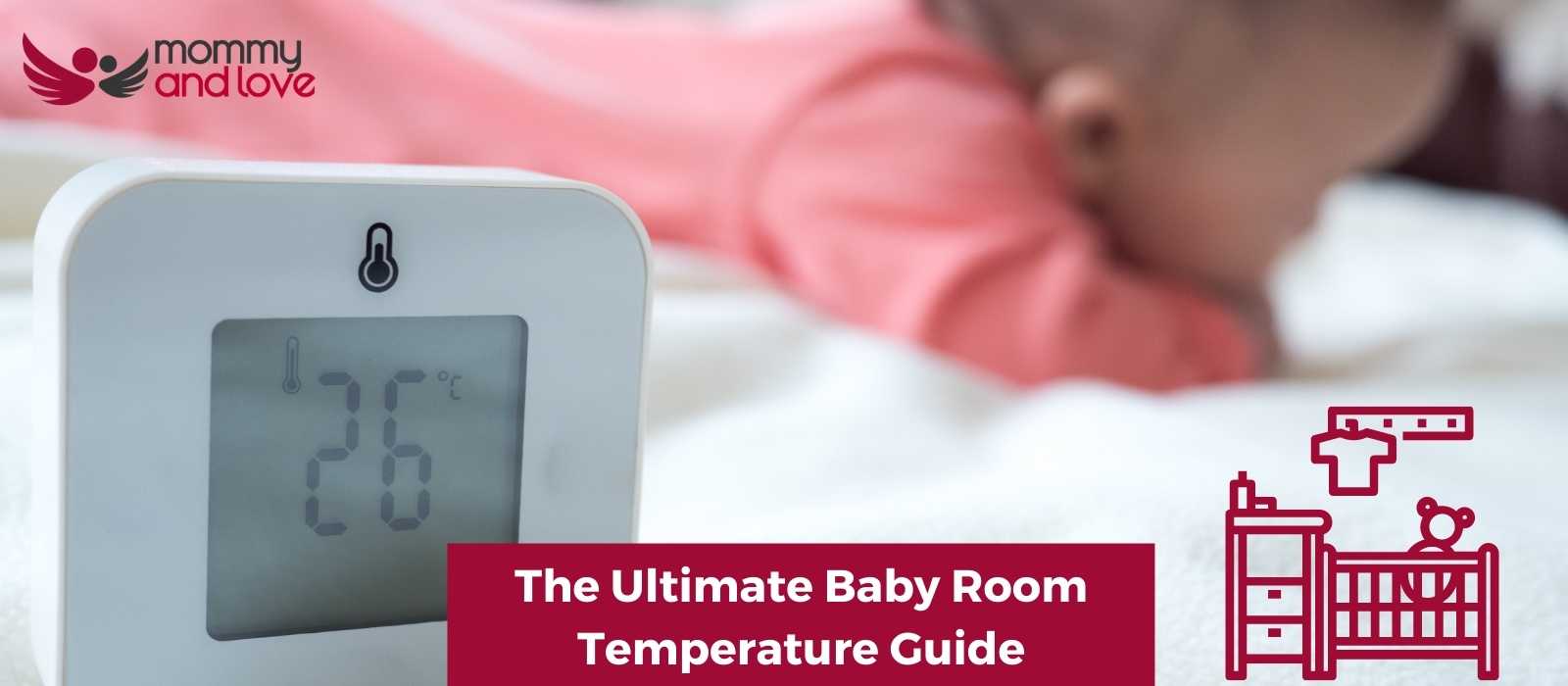It’s vital that you keep your baby’s room temperature at the optimal level when they are sleeping. Too hot or too cold and your little one could become uncomfortable, sick, or even die.
Affiliate Disclaimer: As an Affiliate, we earn from qualifying purchases.
What Is the Best Room Temperature for Babies When Sleeping?
The ideal room temperature for babies when sleeping is between 68 and 72 degrees Fahrenheit. If the room is too hot or too cold, it can be uncomfortable for your little one. It can also lead to health problems such as dehydration, overheating, and respiratory infections.
It is vital that your baby sleeps in a safe sleep environment and this includes keeping a bare crib, making sure there is no soft bedding on which he can suffocate, putting him to sleep on his back and ensuring the normal temperature in the room is the right temperature.
The safest room temperature is between 68-72, but also remember the bedroom temperature can vary within the room depending on whether your baby is in direct sunlight or even in a draft. Ideally its better if your baby’s sleeps in the same room as you so you can ensure that you
How to Regulate Baby Temperature When Sleeping?
To ensure your baby’s sleeping environment is at the ideal temperature:
– Use a thermometer to check the room temperature before putting your baby down for a nap or nighttime sleep.
– Adjust the thermostat or use a space heater or fan to maintain a comfortable temperature.
– Dress your baby in light clothing for sleep, and use a light blanket or sleep sack if needed A long-sleeved vest underneath the sleep sack makes a perfect extra layer.
– Keep the room well-ventilated to prevent stuffiness.
Risks When Babies Sleep With Wrong Temperature
There are many risks associated with babies overheating when sleeping. These risks can include dehydration, heat stroke, and even death from sudden infant death syndrome (SIDS). It is important to make sure that your baby is not too hot when sleeping, as this can be a serious health hazard. Here are some tips to keep in mind to help avoid this problem:
If you think your baby may be overheating, remove any excess clothing or blankets and offer them a cool drink of water. If they are still sweating or appear to be in distress, call your doctor or take them to the emergency room immediately.
Overheating is a serious problem that can be easily avoided. By taking some simple precautions, you can help keep your baby safe and comfortable when sleeping.
Too Hot
If the room is too hot, your baby could become dehydrated or overheat. Symptoms of overheating include sweating, flushed skin, rapid breathing, and a rapid heartbeat.
Overheating can also cause restless sleep, nightmares, and night terrors. If your baby’s body temperature gets too high, it can lead to heatstroke, which is a life-threatening condition.
Too Cold
If the room is too cold, your baby could become hypothermic. Symptoms of hypothermia include shivering, blue skin, and slow breathing.
Hypothermia can also cause sleep problems, including insomnia. If your baby’s body temperature gets too low, it can lead to death.
What Is the Danger Zone for Baby Sleep?
Babies and toddlers are at risk for heat stroke when their internal body temperature reaches 104 degrees Fahrenheit. Symptoms of heat stroke include:
– Hot, red, dry skin
– No sweating
– High body temperature
– Rapid heartbeat
– Difficulty breathing
– Dizziness or confusion
If you think your baby or toddler has heat stroke, call 911 immediately. Heat stroke is a medical emergency and can be fatal if not treated promptly.
Are Babies Temperatures Lower When They Sleep?
Yes, babies’ internal body temperatures are lower when they sleep. This is why it’s important to keep the room temperature at a comfortable level for your little one.
It is important that you have an indoor thermometer and monitor the sleeping baby’s room.
Ideally, you should have a thermometer close to the baby’s crib, away from any drafts or heat sources that may affect the reading.
I love this room thermometer with remote monitoring app, it also has a humidity monitor and more importantly notification alerts if the range is outside the specified range.
A baby’s internal temperature is lower than an adult’s, so they are more susceptible to changes in their environment. With a sleeping baby, their metabolism slows down and their body temperature drops.
This is why it’s important to keep the room temperature at a comfortable level for your little one.
How Can I Tell if My Baby Is Too Hot or Too Cold?
There are a few things you can look for to help you determine if your baby is too hot or too cold. If your baby is too hot, they may have flushed cheeks and be sweating. They may also have a rapid heartbeat.
If your baby is too cold, they may have blue lips and fingers. They may also be shivering. You can also feel your baby’s chest to see if it is warm or cool.
There are a few ways to tell if your baby is too hot or too cold:
– Check the room temperature with a thermometer.
– Feel your baby’s skin to see if it’s warm, hot, or cold to the touch.
– Observe your baby for signs of discomfort such as sweating, shivering, or restless sleep.
If you’re unsure whether your baby is too hot or too cold, err on the side of caution and dress them in lighter clothing or use a light blanket or light sleep sack.
Watch for Overheating
To avoid overheating in warm weather, dress your baby in light layers. You should also avoid using blankets or quilts. If you are using a blanket, make sure it is lightweight and breathable. You can also use a sleep sack instead of a blanket. Feel your baby’s skin and if they feel warm, remove the extra layer.
If the baby wakes sweating, then remove the blankets completely. It can be hard to get the right room temperature, and how many blankets your baby’s room needs can really depend so go with your gut and see how your baby looks and feels feel baby’s hands to see how they fee.
If the room is too hot you can keep the bedroom door open to allow some air in or you can turn on the air conditioning or a fan. Being too hot can put them at risk of sids so its best to err on the side of caution and remove the baby’s risk by removing one or more layers.
Keep the Room Cool
The ideal room temperature for a baby’s bedroom is between 68-72 degrees Fahrenheit. You can use a fan in the room to help circulate the air and keep the room cool.
For the first six months, babies cannot regulate their own temperature so one of the best parenting tips you can get is to avoid over bundling. In the winter months you can add in extra layers as needed but in the warmer months keep them cool, not only will it help the baby to sleep better, but if they are cooler their risk of SIDS is much lower.
Monitor Your Baby’s Clothing
You should dress your baby according to the temperature outside. If it is warm outside, dress them in light, breathable clothing. If it is cold outside, dress them in layers so you can adjust as needed.
Check for Sweating and Block the Sun
If it is hot outside, you will want to check for sweating and make sure your baby is not in direct sunlight. If they are sweating, you can remove a layer of clothing. If they are in direct sunlight, you can the crib to a shadier part of the room or use a blackout blind.
You can also use these tips to help you regulate your baby’s temperature when you are indoors. If you are using a space heater or air conditioner, make sure it is not blowing directly on your baby. You should also monitor the humidity in the room and keep it between 30-50%.
Keep Cribs Bare
To avoid your baby getting too hot or cold, you should keep the crib bare. This means no blankets, pillows, quilts, or stuffed animals. Your baby should only have a fitted sheet on the mattress.
Use a Room Thermometer
You can use a room thermometer to help you monitor the temperature in your baby’s room. This will help you make sure the room is not too hot or too cold.
Ensure Baby is Fully Dry After a Bath
If having a bath before bedtime is part of your nighttime routine for helping your baby to sleep, ensure that you fully dry their hair. Having damp hair could cause them to get a chill.
Baby Sleeping Temperature FAQs
When can babies start to regulate their temperature?
Babies can start to regulate their temperature around the age of six months. This is when they begin to develop the ability to sweat. Sweating helps to cool the body down and so babies who can sweat are better able to regulate their temperature.
However, it is important to note that sweating is not the only way that babies can regulate their temperature. They can also use other methods such as panting and vasodilation.
Panting is a way of cooling the body down by increasing evaporation. This is why you may see a baby panting after a feed or during a hot day. Vasodilation is when the blood vessels open up to allow more blood to flow. This helps to cool the body down as well.
So, if you see your baby sweating, panting or vasodilating, don’t worry! They are just regulating their temperature.
How can I keep my baby cool without AC?
There are a few things you can do to help keep your baby cool without AC. First, make sure they are dressed in light, loose-fitting clothing. Also, try to keep them out of direct sunlight as much as possible.
And lastly, give them plenty of fluids to drink to prevent dehydration. By following these tips, you can help keep your baby cool and comfortable all summer long.
What Should the Thermostat Be Set at for a Baby?
The answer to this question depends on a few factors, such as the age of the baby, the temperature outside, and the home’s heating and cooling system. In general, it is best to keep the thermostat set at a comfortable temperature for adults, around 70 degrees Fahrenheit.
However, if the home is particularly warm or cool, you may need to adjust the thermostat accordingly. If you are unsure, it is always best to err on the side of caution and keep the temperature a bit cooler than usual. Babies tend to be more sensitive to extreme temperatures than adults, so it is better to err on the side of caution when setting the thermostat.
The Bottom Line on Best Baby Room Temperature
There are a few things you can do to help keep your baby cool during the summer months, and warmer in winter to ensure you have the best temperature for them. By following these simple tips, you can help your baby sleep comfortably and safely all year round.
Many parents don’t realise that babies need to be the same temperature that you feel comfortable in. So follow those guidelines and you should have the ideal temperature for your baby to sleep safely.

This article was written by Sandra Baker – full time writer and the mother of four amazing kids (including twins!)
She’s also a breastfeeding counselor and has spent years helping new parents learn how to care for their children. When she’s not writing or caring for her children, Sandra likes to spend time reading and taking walks with her husband.





